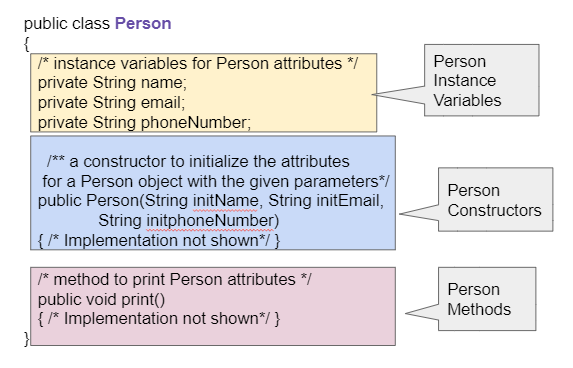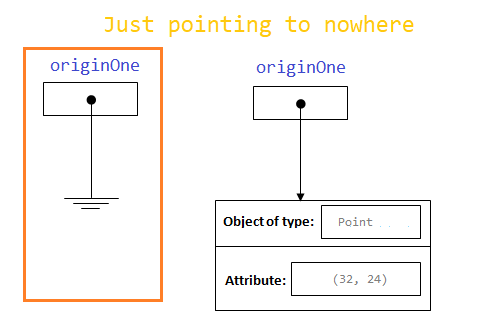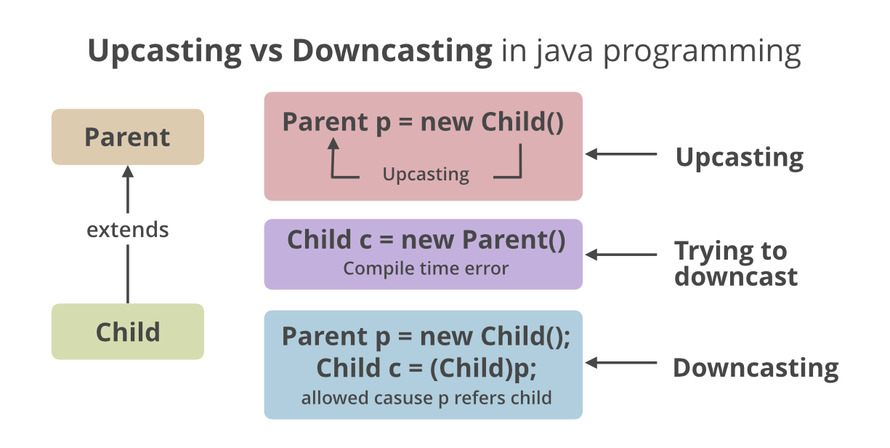Java SE: Class and Objects
Java Fundamentals
📘 What is a Java Class
A Java class is a template for creating objects, defining object data types and methods. A class is a blueprint for objects, and an object is an instance of a class.
In other words, a class def>ines the properties and behaviors that objects created from the class will have.
For example, if you have a class called “Dog,” objects created from that class might have properties like “breed” and “age,” as well as behaviors like “bark” and “fetch.” Classes are an important concept in object-oriented programming, and are a fundamental building block of Java programs
📘 What is a Java Object
An object in Java is a container that holds both data and behavior. The data is represented by the object’s attributes, and the behavior is represented by the methods that operate on those attributes.
When you create an object, you are creating an instance of a class, which is a blueprint or template for the object.
1 Class
Let’s create a class called Person.
What would we want to know about a person? What we want to know depends on what problem we are trying to solve. In one situation, perhaps when creating an address book, we might want to know the person’s name and phone number and email.
Here’s a possible Person class with:
fieldsorattributes(instance variables),constructor,- and
methods.
Person.java
public class Person {
//fields
private int age;
private String name;
private String address;
private double salary;
private String phoneNumber;
private String email;
//constructor
public Person(int age, String name, String address, double salary) {
this.age = age;
this.name = name;
this.address = address;
this.salary = salary;
this.email = email;
this.phoneNumber = phoneNumber;
}
//constructor
public Person(int age, String name, String email, String phoneNumber) {
this.age = age;
this.name = name;
this.address = address;
this.salary = salary;
this.email = email;
this.phoneNumber = phoneNumber;
}
//methods
public int getAge() {
return age;
}
public void setAge(int age) {
this.age = age;
}
public String getName() {
return name;
}
public void setName(String name) {
this.name = name;
}
public String getAddress() {
return address;
}
public void setAddress(String address) {
this.address = address;
}
public double getSalary() {
return salary;
}
public void setSalary(double salary) {
this.salary = salary;
}
public void study() {
// Do some work here
}
public void receivePaycheck() {
// Process salary and distribute paychecks
}
public void getOlder() {
this.age++;
}
}2 Objects
Each object has its own unique identity, and it maintains its own state by storing the values of its attributes. The object’s behavior is defined by the methods that operate on its attributes, and these methods can be invoked by other code to ask the object to perform a specific action.
Objects are an essential concept in object-oriented programming, and they are used to model real-world entities in a program. For example, you could create an object to represent a particular person, with attributes such as name, age, and address, and methods that operate on these attributes, such as a method to calculate their age in a particular year.
In Java, you can create objects by using the new keyword and the class constructor to allocate memory for the object, and then you can access the object’s attributes and methods by using the . (dot) operator. For example, if you have a class called Person, you could create an object of that class like this:
And then you could access the object’s attributes and methods like this:
carla.name = "Carla Whitesand";
carla.setAddress("123 Main Street");
int age = carla.calc>ulateAge(2022);In this example, name and setAddress() are attributes and methods of the Person class, and person is an object of that class. You can use this object to store and manipulate data according to the rules defined by the class.
3 Creating Objects
As you know, a class provides the blueprint for objects; you create an object from a class. Each of the following statements taken from the CreateObjectDemo program creates an object and assigns it to a variable:
Point originOne = new Point(23, 94);
Rectangle rectOne = new Rectangle(originOne, 100, 200);
Rectangle rectTwo = new Rectangle(50, 100);The first line creates an object of the Point class, and the second and third lines each create an object of the Rectangle class.
Each of these statements has three parts (discussed in detail below):
- Declaration: The code set in bold are all variable declarations that associate a variable name with an object type.
- Instantiation: The new keyword is a Java operator that creates the object.
- Initialization: The new operator is followed by a call to a constructor, which initializes the new object.
3.1 Declaring a Variable to Refer to an Object
Previously, you learned that to declare a variable, you write:
type name;
This notifies the compiler that you will use name to refer to data whose type is type. With a primitive variable, this declaration also reserves the proper amount of memory for the variable.
You can also declare a reference variable on its own line. For example:
If you declare originOne like this, its value will be undetermined until an object is actually created and assigned to it. Simply declaring a reference variable does not create an object.
For that, you need to use the new operator, as described in the next section. You must assign an object to originOne before you use it in your code. Otherwise, you will get a compiler error.
A variable in this state, which currently references no object, can be illustrated as follows (the variable name, originOne, plus a reference pointing to nothing):
originOne –> null
4 Instantiating a Class
📘 Instantiating a Class
The new operator instantiates a class by allocating memory for a new object and returning a reference to that memory. The new operator also invokes the object constructor.
The phrase “instantiating a class” means the same thing as “creating an object.” When you create an object, you are creating an “instance” of a class, therefore “instantiating” a class.
The new operator requires a single, postfix argument: a call to a constructor. The name of the constructor provides the name of the class to instantiate.
The new operator returns a reference to the object it created. This reference is usually assigned to a variable of the appropriate type, like:
originOne –> Point object
The reference returned by the new operator does not have to be assigned to a variable. It can also be used directly in an expression. For example:
This statement will be discussed in the next section or you can go here.
4.1 Initializing an Object
Here’s the code for the Point class:
public class Point {
public int x = 0;
public int y = 0;
//constructor
public Point(int a, int b) {
x = a;
y = b;
}
}This class contains a single constructor. You can recognize a constructor because its declaration uses the same name as the class and it has no return type.
The constructor in the Point class takes two integer arguments, as declared by the code (int a, int b). The following statement provides 23 and 94 as values for those arguments: Linux Lab#LI01-1: Export env user with grep and pipe
4.2 Example UML: class and object
5 Ways to create an object
There are several ways to create objects in Java:
- Using the
newoperator: this is the most common way to create an object in Java. It involves using the new operator followed by the class name and constructor arguments. For example:Implicit casting
- Using the
clone()method: if you want to create a copy of an existing object, you can use the clone() method.
This method is defined in the java.lang.Object class, which is the superclass of all Java classes. To use the clone() method, you’ll need to implement the Cloneable interface in your class and override the clone() method.
Using
factorymethods: A factory method is astaticmethod that returns an instance of a class. Factory methods are often used to create objects when you need more flexibility or control over the object creation process.Using
reflection: Reflection is a feature of the Java language that allows you to inspect and manipulate the structure of a class at runtime.
You can use reflection to create objects by invoking the newInstance() method on the Constructor object for a particular class.
- Using object
deserialization: You can use object deserialization to create an object from its serialized form, which is a stream of bytes that represents the object’s state.
To do this, you’ll need to implement the Serializable interface in your class and use the ObjectInputStream and ObjectOutputStream classes to serialize and deserialize the object.
6 Casting (typecasting)
Casting is the process of converting one type of data to another type. There are two types of casting: explicit and implicit.
6.1 Explicit casting
Explicit casting is when you specify the type you want the data to be converted to. An example of explicit casting is:
In this case, the double value of 3.14 is being explicitly cast to an int.
6.2 Implicit casting
Implicit casting, also known as widening, is when the conversion happens automatically without the need for a specific type to be specified. An example of implicit casting is:
It’s important to note that casting can cause data loss if the type being converted to cannot hold the value of the original type. For example, casting a large double value to an int would result in the decimal places being truncated and lost.
In this case, the int value of 3 is being implicitly cast to a double.
6.3 Casting in compilation/execution time
It is important to consider the class of the object and the type of its reference variable when casting, as it can affect both the compilation time and execution time of a program.
During compilation, the compiler checks the source code for any type errors and other issues related to casting, such as trying to cast an object to a class that it is not compatible with. If any errors are found, the compiler will display them and the program will not be able to run until they are fixed. This means that understanding the class of an object and the type of its reference variable is crucial for avoiding casting errors during compilation.
Compilation time refers to the period of time during which the source code of a program is translated into machine code by a compiler. This is the initial phase of program execution.
At execution time, casting can also have an impact on the performance and behavior of a program. For example, if a program tries to cast an object to a type that is not compatible with its class, a runtime exception will be thrown, causing the program to crash.
Execution time refers to the period of time during which the compiled program runs and performs its intended operations. This is the phase of the program when it’s executed by the CPU and its instructions are executed.
On the other hand, if the casting is done properly and the object is compatible with the target type, it can improve the performance and efficiency of the program.
Knowing the class of an object and the type of its reference variable is also important for making sure the program is using the right methods and properties of the object, and for avoiding unexpected behavior.
6.4 Upcasting and downcasting
Before reading this section you must read and understand how does inherence work
6.5 Upcasting
Upcasting is casting a subtype to a supertype, upward to the inheritance tree. Upcasting happens automatically and we don’t have to explicitly do anything.
TypeCasrting.java
// Base Class
public class Animal
{
public void talk() { System.out.println("I am talking"); }
}
// Inherited class
class Cat extends Animal
{
// This method overrides show() of Parent
@Override
public void talk() { System.out.println("Miauuu, miauuuu, miauuu!!!"); }
}
public class Test
{
public void testUpCasting(){
Animal cat = new Cat();
cat.talk();
// output: Miauuu, miauuuu, miauuu!!!)
}
}6.6 Downcasting
When Subclass type refers to the object of Parent class, it is known as downcasting. If we perform it directly, compiler gives Compilation error. If you perform it by typecasting, ClassCastException is thrown at runtime (sometimes we may use instanceof operator, then downcasting is possible)
TypeCasrting.java
// Base Class
public class Animal
{
public void talk() { System.out.println("I am talking"); }
}
// Inherited class
class Cat extends Animal
{
// This method overrides show() of Parent
@Override
public void talk() { System.out.println("Miauuu, miauuuu, miauuu!!!"); }
}
public class Test
{
public void testDownCasting(){
Cat cat = new Animal();
// compiling time error, try to cast but it can not
Animal animal = new Animal();
// creatng an object of the superclass is ok
Cat cat = (Cat) animal;
// downcasting
cat.talk();
// output: Miauuu, miauuuu, miauuu!!!)
}
}




